Oakley glasses, MTB tyres, one-piece alu frames, Lefty forks: all created in the 1890s
Many of the things we consider ‘modern’ about cycling – even basic things such as anti-puncture gloop or hi-viz clothing – were available to Victorian cyclists. Below are a number of products from the 1890s which you may not not have realised were available to cyclists more than one hundred years ago. In the ten years before 1900, a third of ALL new patent applications at the US Patent Office were bicycle-related; in Britain more than half of the 28,000 patents filed in 1896 were for improvements in bicycles. The weight of an average Safety bicycle in 1892 was 42 pounds; by 1897 it was 22 pounds. There are even claims – perhaps fanciful, but reported widely – that racing bikes could be as eye-wateringly light as 9lbs. The white heat of innovation made cycling very attractive and the bicycle was the technological wonder that led to key developments in the just-starting automotive and aeronautical industries.
‘OAKLEY’ SPORTS SHADES
Oakley, the sportshade-to-softwear brand, was started in 1975 by Jim Jannard. He made handlebar grips for MX motorbikes. Five years later he created a pair of goggles which he called the O-frame. In 1984 the company’s fortunes were transformed by the release of Eyeshades, the ‘Factory Pilot’ shades popularised by Greg LeMond and Andy Hampsten.
Oakley’s were famously wraparound, had a sweat-absorbing pad and came with lenses available in lots of colours. All highly original.
Well, except a very Oakley-like set of shades existed in the mid-1890s. The Lamb Eye Shield was a commercial product, advertised in cycling magazines. The advert above appeared in a copy of the League of American Wheelman’s ‘Good Roads’ magazine of 1897.
Benjamin Lamb of Boston, USA, filed a patent for his eye shield in 1891 and this was granted in 1895. He invented the product for use when “driving”, and by this he means the driving of a horse and carriage. The popularity of cycling in the 1890s gave Lamb a new market.
The Lamb Eye Shield was “light, flexible…” and available with lens colours “clear, green, blue or smoke.” The lens was made from flexible sheet mica, a plastic laminate.
In his patent, Lamb said his Eye Shield “prevents interference with the sight in any direction, while the eyes are protected from heat by the non-conductive nature of the material forming said lenses, and from dust or snow or other flying particles.”
Mica was used because “such material, possessing no magnifying qualities, the sight is not thereby interfered with. Moreover, all danger from breaking the lenses as when glass is used is overcome.”
Lamb’s Eye Shield was made from fabric, with felt padding, and had “ventilation openings” to “prevent moisture from the face from collecting in the inner side of the lenses, and injury to the eyes from confining the air which would gradually become heated by contact with the body of the wearer.”
Lamb came from a Boston wealthy family, and had the money to advertise his product in 1897. According to a listing in the New England Telephone and Telegraph Company directory, the Lamb Eye Shield Company was still trading in 1900.
KNOBBY TYRES
Most solid tyres of the 1870s and 1880s were smooth; most pneumatics (available from the end of the 1880s) were patterned with grooves. However, for serious mud-plugging on an overseas tour on Humber Safety cycles in 1893, the Stead brothers were equipped with the “latest bicycle Torrilliou pneumatic tyres and Edwards’ corrugate cover.”
According to an article in their father’s The Daily Paper (a short-lived publication from the father of New Journalism, creator of the tabloid reporting style, and who in 1912 went down with the Titanic), this “corrugate cover”…
…was an immense success, and attracted great attention whenever the cycles stopped. They were the first of the kind that had been seen in France, and they were very greatly admired, not without cause, for they entirely prevent side-slipping, and they render riding in rain and mud as safe as in dry weather.”
MONO-STAY FORKS
With Olympic cycling champions coming out of our ears it’s easy to forget that before Chris Boardman’s victory at the Barcelona Games, no Briton had cycled to gold since 1920. Boardman’s crushing pursuit victory kick-started a revolution that eventually made Chris Hoy a knight of the realm.
 All of this may have been but dreams were it not for the Invincible made by the Surrey Machinist Co. of Great Suffolk Street, London. This company was noted for its high wheelers but in 1889 it created a bicycle that would have almost zero impact at the time but which, about 100 years later, went on to influence what would become the Lotus Superbike, the carbon monocoque bicycle used by Boardman in Barcelona.
All of this may have been but dreams were it not for the Invincible made by the Surrey Machinist Co. of Great Suffolk Street, London. This company was noted for its high wheelers but in 1889 it created a bicycle that would have almost zero impact at the time but which, about 100 years later, went on to influence what would become the Lotus Superbike, the carbon monocoque bicycle used by Boardman in Barcelona.
In the late 1980s the cycle designer Mike Burrows – a machinist with a workshop on a Norwich industrial estate – visited Coventry Transport Museum and had a light-bulb above the head moment when he saw the Invincible, a mono-stay cruciform bicycle that is surprisingly modern looking.
The Invincible uses a single fork on both wheels and Burrows recognized its engineering simplicity had aerodynamic potential. He adapted the idea for what was to become the famous Lotus bike (and which later inspired Cannondale’s Lefty fork) and the rest, as they say, is history.
FULL BODY ARMOUR
This aluminium full body armour suit was patented in 1897. It probably never went into production. Nevertheless, some inventive Victorians were clearly way ahead of their time.
HI-VIZ CLOTHING
This luminous cap from 1897 was soaked in phosphorus and there were also chemical treatments to turn tweed cycling suits into glow-in-the-dark outfits. It’s unlikely many went into full-scale commercial production, probably because there was little need – or desire – for such conspicuity. Today’s hi-viz clothing is meant to warn drivers of the presence of a road user unprotected by a two-ton exoskeleton; the Victorians who thought about wearing chemically-treated garb were more fussed about whether the luminosity would mean no fine would be levied by a police officer who caught them in the dark with a borked oil-lamp.

DUNLOP PUNCTURE STOP
The brightly-coloured gloop we sometimes put in our tyres to prevent punctures isn’t a new invention, Griffiths Cycle Corporation of Coventry had a version of the product in 1897. Griffiths was the Madison-cum-Chain-Reaction-Cycles of its day, with ‘depots’ in most British cities as well as branches in France, Belgium and Canada. Griffiths was owned by Dunlop.
MUC OFF BRUSH SET
Victorians had to endure muddy/dusty roads, depending on the season, but their bicycles, as luxury items, had to be spotless so there were all manner of products to keep them clean, including this brush set. Who did the cleaning? Servants, of course. But they weren’t always appreciated, as this comment from an upper-class owner in 1897 can attest:
“One of the most fatal mistakes that can be committed by the owner of a bicycle is accomplished when she entrusts the treasured possession to the temporary care of the servant.
“With the best intentions in the world, the ordinary domestic does not shine with glory in the rôle of cycle attendant, and it is, I venture to think, questionable whether the servants who quite unconsciously inflict the most injury upon a bicycle are ranked amongst the very careless or the very careful.
“From the careless servant I suppose we have all suffered. She has but little property of her own, and cannot be taught to respect the possessions of others.
“[She] prefers to scrub out the lobby without removing the machine. When she observes the consequent splashings upon the tubing and the rims – which is not often, for she is not a lady of observant nature – she wipes them off with her damp house flannel, and concludes that she has conscientiously performed her duty in the station of life to which she has been called.
“To ask such a woman to clean the machine after a muddy run is to voluntarily drop five pounds sterling in as many minutes. It is to the very careful servant to whom this sacred duty is sometimes entrusted, and, alas! too often has the careful servant been weighed in the balance and found wanting.
“The mistakes she makes are the mistakes born of indiscriminate energy and misdirected zeal.
“Yes, both classes of the domestic certainly manage to injure the bicycle, and although I have suffered from both of them, I do not know which of them can be regarded as the lesser evil of the two.”
CYCLE TRAINER WITH 3D VIEWS OF A ROLLING ROAD
 “Our weather is such that for at least one quarter of the year we must cycle at home or not at all,” stated a correspondent to the short-lived The Rambler weekly cycling magazine in 1897.
“Our weather is such that for at least one quarter of the year we must cycle at home or not at all,” stated a correspondent to the short-lived The Rambler weekly cycling magazine in 1897.
“Most of us do not cycle,” he continued, “preferring to abandon our wheel rather than attempt to deceive ourselves with an apology for a spin, but just a few cyclists, on the principle, no doubt, that half a loaf is better than no bread, cover a few miles on their home trainers.”
Such trainers were nothing new in 1897. Riders of high-wheelers and tricycles had such devices in the 1880s.
And if you think enlivening boring turbo training by watching a DVD of a road scene is somehow modern, think again. In The Rambler of 1897 there’s a description of an indoor cycle trainer with a painted 3D rolling background, and fans to simulate wind:
“One rider…in an endeavour to impart realism to his indoor journeys, contrived an ingenious affair by which he was able to enjoy in unpropitious weather all the pleasures of a country run…He was a scene painter by profession…he painted on canvas rolls two long country views – fields, villages, towns, etc. These he fixed on rollers, and placed either side of his stationery machine. The working mechanism of these rollers was cleverly connected with the rim of the far wheel of the bicycle by means of thin wire ropes, which ran over rollers worked by the revolution of the wheel, and so the strips of scenery on both sides of him were put into action…As he pedalled away he seemed to be passing the country as the scenes were slipping by on his right and his left…But this was not sufficient; he required the rush of air to heighten the deception. He pressed into service four circular fans…And thus he was able to enjoy a ride, the realism of which left little to be desired.”
AEROBARS
Greg LeMond used a set of aerobars to win the 1989 Tour de France. Scott USA, a ski company turned bike maker, is credited with the design for these bars. They were developed in 1987 by ski coach Boone Lennon. But cycle historian Jim Langley says the first aerobars were invented in 1984 by Richard ‘Speedplay’ Bryne for Jim Elliot to use in the 1984 Race Across America.
But perhaps the first aerobars were developed much earlier than 1984?
 Cycling Life of 1896 records that the inventor of this handlebar set-up was Sylvester E Cleveland of Harrison, Illinois. The handlebar rests were meant to provide “wonderful benefits to those who race, as well as those who indulge in long distance riding.”
Cycling Life of 1896 records that the inventor of this handlebar set-up was Sylvester E Cleveland of Harrison, Illinois. The handlebar rests were meant to provide “wonderful benefits to those who race, as well as those who indulge in long distance riding.”
The science of aerodynamics was still some years off and while Cleveland’s innovation would have had aero benefits the design was probably more to allow a moving cyclist to rest awhile..
Talking about aerodynamics, the aero testing wind tunnel was invented by a pair of bicycle mechanics: the Wright Brothers.
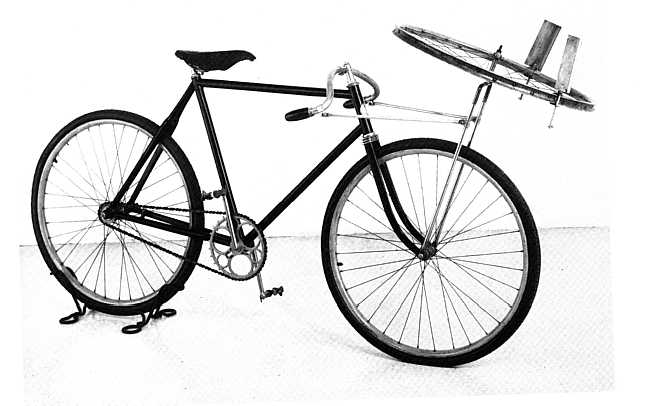
A handlebar-mounted wheel was fitted with two metal plates, one flat, one curved, ninety degrees apart. Orville and Wilbur used the device to measure air resistance.
“The results obtained with the rough apparatus…gave evidence of such possibility of exactness,” wrote Wilbur.
By riding along and generating some wind flow, the brothers were able to disprove earlier theories on lift.
The brothers later invented the wind tunnel to fine tune their early experiments in aerodynamics. This was a box six feet long and sixteen inches square on the inside. They mounted a fan attached to a sheet metal hood to one side and replaced a panel on the top of the box with a pane of glass so they could see inside. The fan moved the air through the tunnel at 27 miles per hour and the brothers tested hundreds of small sections of wings and wing shapes. High-tech wind tunnels would, of course, be later used to fine-tune the best aerodynamic shapes for bicycles…
ONE-PIECE ALU FRAMESThink Gary Klein in the 1970s brought out the first alu-framed bike? Think again, aluminium framed bicycles were available in the 1890s. The Lu-Mi-Num brand of cycles is thought to have been the first and were made by the St Louis Refrigerator and Wooden Gutter Company from 1893 through to at least 1897. The Lu-Mi-Num had a sloping top-tube, aero-style forks and the alu frame was made in one-piece, a radical innovation for the time. The rights to the manufacturing method, and the brand name, were acquired by M. M. Cycles of Paris and Lu-Mi-Num Mfg of London.
The Lu-Mi-Num “frame is one complete and perfect piece of metal, without joints or parts of any kind,” said a writer from Referee, a US bicycle trade magazine, who visited the St Louis plant in 1896. His description of the manufacturing process sounds similar, in part, to the monocoque construction of today’s composite frames:
“The moulding shop was first visited. Here was shown a mould for a complete frame. This is cut into halves before use….Steel cores are then placed in one half of the frame, securely fastened, and then the other half is placed into position…The frame is then cemented and ready for the oven. Into this it is put and not until the mould is at white heat is it withdrawn for the purpose of receiving the metal. The aluminum is prepared in a furnace…After the mould is taken from the oven it receives the aluminum, after which it goes through a cooling process; then the frame is withdrawn and the steel cores pulled out.”
It’s likely the Lu-Mi-Num frame would have been much more flexible than a steel framed bicycle of the time (there’s a reason Klein and Cannondale made their bikes from fat alu tubes) and the aluminium used was purer then today’s alloy frames, making it more brittle.
A promotional medal for the Lu-Mi-Num, minted in 1894, loftily claimed the bike had “Many advantages” and “No disadvantages.” The advantages were said to be
No more steel to rust
No more tubing to bend
No more heavy machines
No more light ones breaking down
No more brazed joints to give out

At 25lbs, the Lu-Mi-Num was by no means the lightest bicycle of the mid-1890s, see below, but Lu-Mi-Num was ahead of the time when it produced integrated components for its frames, including in 1896, a one-piece women’s frame with an integrated chain case. It also has an integrated bottom bracket and an integrated headset.
The photos below are by Matt McNeece from Des Moines, Iowa. They show his great-great grandfather’s stunningly-beautiful 1896-vintage Lu-Mi-Num bike.
Matt told me: “I’ve since found an older Brooks saddle to put on it. It still isn’t an antique saddle but patina matches better. Sadly, the crank arms have twisted over time so it would be really hard to ride. I also had to re-spoke the wheels five years ago or so and I didn’t take them to full tension in an effort to save the wooden rims from damage.”
LIGHTWEIGHT BICYCLES
Schwinn’s World Flyer racing bike of 1896 weighed what carbon road bikes do today, between 16 to 18 pounds.
In 1940, Detroit’s most famous cyclist, the 77-year old Henry Ford, was featured in Time magazine riding what was claimed to be a 12lb English bicycle. This seems unlikely, at first, but such a bike was positively porky compared to the racing bike made by Louis Jordan, a “high-grade” bicycle manufacturer in Chicago. Referee trade magazine of 1896 claimed Jordan’s stripped-back racing bike weighed 9lbs and the firm produced a roadster weighing 14lbs.
In Scribner’s Magazine (June, 1895) Gilded Age architect Philip G. Hubert of New York wrote:
“aluminum seems likely to achieve wonders for the bicycle in the near future…Some of the lightweight machines were wonderful [at the recent show] especially one weighing less than nine pounds, which was ridden at the show by a man weighing more than two hundred pounds. Five years ago the average weight of the road bicycle was from forty to fifty pounds. Now, anything weighing more than twenty-five pounds is looked upon with disfavor.”

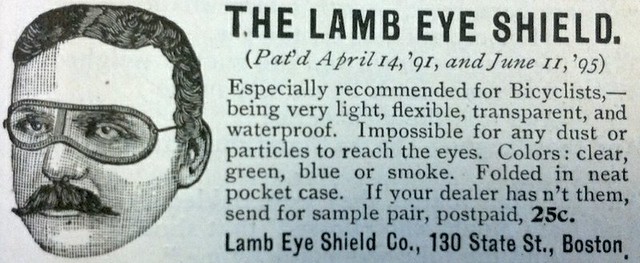



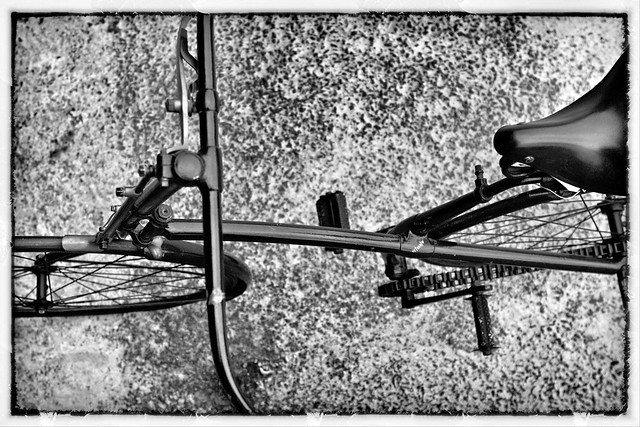

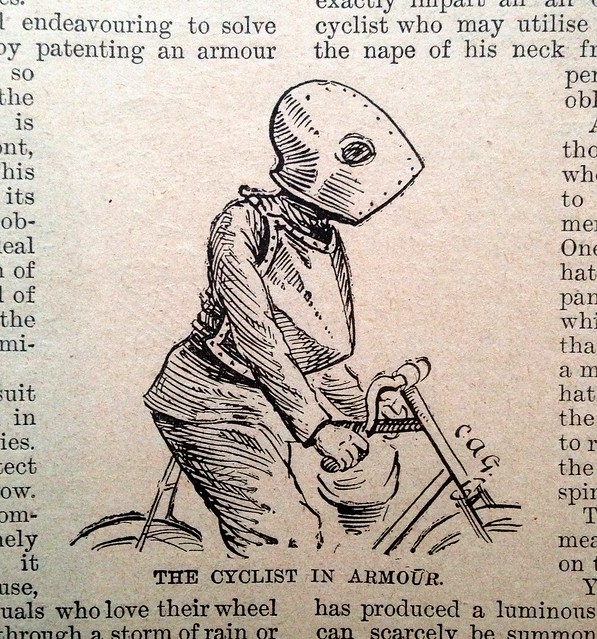
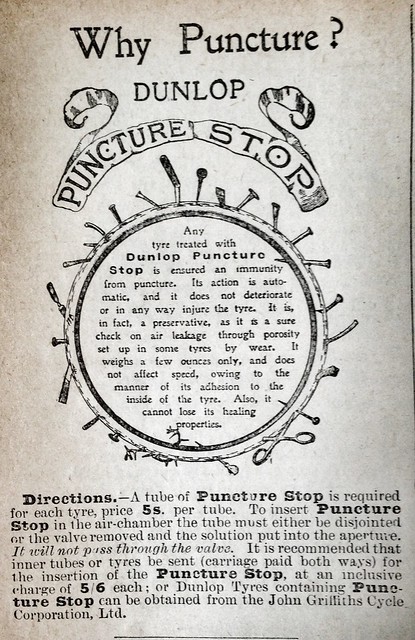
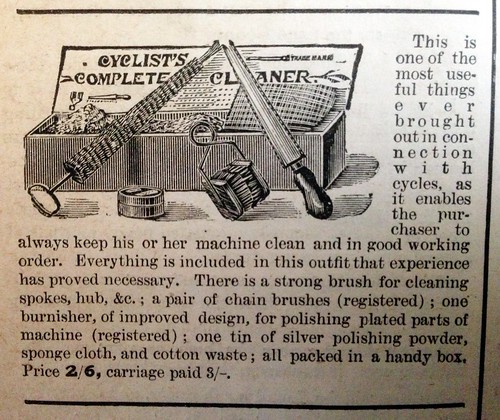






5 thoughts on “Oakley glasses, MTB tyres, one-piece alu frames, Lefty forks: all created in the 1890s”